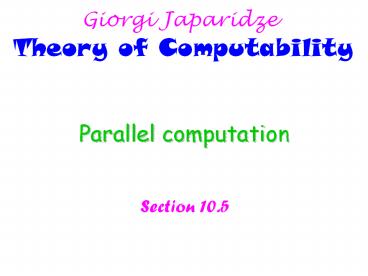Parallel computation - PowerPoint PPT Presentation
Title:
Parallel computation
Description:
Giorgi Japaridze Theory of Computability Parallel computation Section 10.5 Introduction 10.5.a Giorgi Japaridze Theory of Computability A parallel computer is one ... – PowerPoint PPT presentation
Number of Views:55
Avg rating:3.0/5.0
Title: Parallel computation
1
Parallel computation
Giorgi Japaridze Theory of
Computability
Section 10.5
2
Introduction
10.5.a
Giorgi Japaridze Theory of Computability
A parallel computer is one that can perform
multiple operations simultaneously.
Such computers may solve certain problems much
faster than sequential computers, which can only
do a single operation at a time. In practice,
the distinction between the two is slightly
blurred because most real computers (including
sequential ones) are designed to use some
parallelism as they execute individual
instructions (remember pipelining after all). We
focus here on massive parallelism whereby a huge
number (think of millions or more) of
processing elements are actively participating in
a single computation. One of the most popular
models in theoretical work on parallel algorithms
is called the Parallel Random Access Machine or
PRAM. In the PRAM model, idealized processors
with a single instruction set patterned on
actual computers interact via a shared
memory. Our textbook, however, uses an
alternative, simpler model of parallel computers.
Namely, Boolean circuits, already seen in
Section 9.3.
3
Uniform Boolean circuits as parallel computers
10.5.b
Giorgi Japaridze Theory of Computability
In the Boolean circuit model of a parallel
computer, we take each gate to be an individual
processor, so we define the processor complexity
of a Boolean circuit to be its size. We consider
each processor to compute its function in a
single time step, so we define the parallel time
complexity of a Boolean circuit to be its depth.
Any particular circuit has a fixed input
size ( number of input variables), so we use
circuit families as defined in Definition 9.27
for recognizing languages. We however need
to impose a technical requirement on circuit
families so that they correspond to parallel
computation models such as PRAMs where a single
machine is capable of handling all input
lengths. That requirement states that we can
easily obtain all members in a circuit family.
This uniformity requirement is reasonable
because knowing that a small circuit exists for
recognizing certain elements of a language isnt
very useful if the circuit itself is hard to
find. That leads us to the following definition.
Definition 10.34 A family of circuits (C1,C2,)
is uniform if some log space transducer T
outputs ltCngt when Ts input is 1n.
We say that a language has simultaneous
size-depth circuit complexity at most
(f(n),g(n)) if a uniform circuit family exists
for that language with size complexity f(n) and
depth complexity g(n).
4
The class NC
10.5.c
Giorgi Japaridze Theory of Computability
Many interesting problems have size-depth
complexity (O(nk),O(logk n)) for some constant
k. Such problems may be considered highly
parallelizable with a moderate number of
processors. That prompts the following
definition.
Definition 10.38 For i 1, NC i is the
class of languages that can be decided by a
uniform family of circuits with polynomial size
and O(logi n) depth. NC is the class of
languages that are in NCi for some i.
Functions that are computed by such circuit
families are called NCi computable or NC
computable.
5
Main theorems
10.5.d
Giorgi Japaridze Theory of Computability
Theorem 10.39 NC1 ? L.
Proof idea. We sketch a log space algorithm to
decide a language A in NC1. On input w of length
n, the algorithm can construct the description as
needed of the nth circuit in the uniform
circuit family for A. Then the algorithm can
evaluate the circuit using a depth-first search
from the output gate.
Theorem 10.40 NL ? NC2.
Proof idea. Omitted.
Theorem 10.41 NC ? P.
Proof idea. A polynomial time algorithm can run
the log space transducer to generate circuit Cn
and simulate it on an input of length n.
Open problem NCP? Equality here would be
surprising because it would imply that all
polynomial time solvable problems are highly
parallelizable.
6
P-completeness
10.5.e
Giorgi Japaridze Theory of Computability
Definition 10.42 A language B is P-complete
if 1. B?P, and 2. every A in P is log
space reducible to B.
For a circuit C and input string x we write C(x)
to be the value of C on x. The following
language can be called the circuit evaluation
problem.
CIRCUIT-VALUE ltC,xgt C is a Boolean circuit
and C(x)1.
Theorem 10.44 CIRCUIT-VALUE is P-complete.































